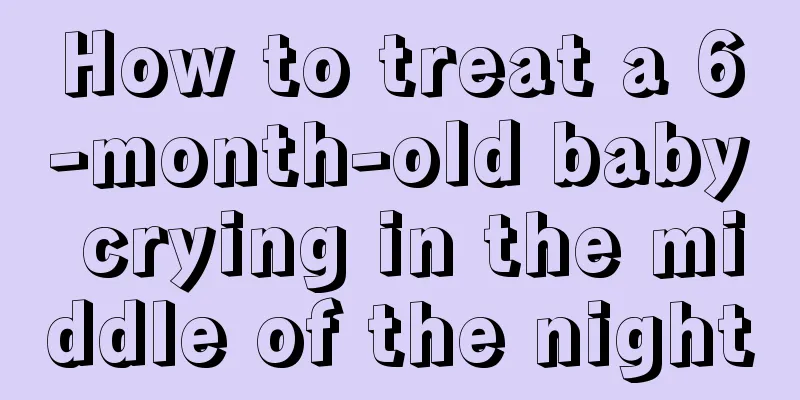Large flat rashes on the child's body

|
Large bumps are generally suspected to be urticaria. Large bumps are bright red or white, and the sizes and conditions of the bumps vary. At the beginning, it is usually a point of uncertain shape, and then merges into a piece. It lasts for a while and then fades away without leaving any scars. Generally, this disease will occur repeatedly in batches, with most cases occurring at night. This disease is very easy to recur, so what are the methods to treat urticaria? treat 1. General treatment Because the causes of urticaria vary, the treatment effects are also different. The specific treatment measures are as follows: (1) Eliminate the cause. Every patient should strive to find the cause of the attack and avoid it. If the cause is infection, the infected lesions should be treated actively. If the allergy is caused by drugs, the allergy medication should be stopped; if the allergy is caused by food, find out the allergic food and do not eat this food again. (2) Avoid inducing factors. For example, for cold urticaria, you should keep warm; for acetylcholine urticaria, you should reduce exercise, sweating and mood swings; for contact urticaria, you should reduce the chance of contact. 2. Medication (1) Antihistamine drugs ①H receptor antagonists have strong anti-histamine and anti-other inflammatory mediator effects and are effective in treating various types of urticaria. Commonly used H1 receptor antagonists include diphenhydramine, cyproheptadine, chlorpheniramine, acrivastine, cetirizine, mizolastine, loratadine, ebastine, azelastine, desloratadine, etc.; when single treatment is ineffective, two different types of H1 receptor antagonists can be used in combination or in combination with H2 receptor antagonists. Commonly used H2 receptor antagonists include cimetidine, ranitidine, famotidine, etc. It is effective for acute, chronic urticaria and cold urticaria. Dosage varies from person to person. ② Doxepin is a tricyclic antidepressant that is particularly effective for chronic urticaria and has fewer adverse reactions. Doxepin is a better choice of drug for patients with urticaria who are not responsive to traditional antihistamines. (2) Drugs that inhibit mast cell degranulation and reduce histamine release ① Meta-hydroxyisobutyrine sulfate is a β2 adrenergic receptor stimulator that can increase the concentration of cAMP in the body, thereby inhibiting mast cell degranulation. ② Ketotifen inhibits mast cell degranulation and prevents the release of inflammatory mediators (such as histamine, slow-reacting substances, etc.) by increasing the concentration of cAMP in the body. Its suppressed. It is stronger and faster than sodium cromoglycate and can be taken orally. ③Sodium cromoglycate can block the binding of antigen and antibody and inhibit the release of inflammatory mediators. If used in combination with glucocorticoids, the dosage of the latter can be reduced and the therapeutic effect can be enhanced. ④ Tranilast reduces the release of histamine by stabilizing the mast cell membrane. (3) Glucocorticoids It is a second-line drug for the treatment of urticaria. It is generally used when severe acute urticaria, urticarial vasculitis, pressure urticaria are ineffective with antihistamines, or when chronic urticaria is severely stimulated. It is given by intravenous drip or orally, and long-term use should be avoided. Commonly used drugs are as follows: ① prednisone; ② triamcinolone; ③ dexamethasone; ④ diprosone. In emergency situations, hydrocortisone, dexamethasone, or methylprednisolone is given intravenously. (4) Immunosuppressants When patients with chronic urticaria have an autoimmune basis, the disease recurs, and the above treatments cannot achieve satisfactory results, immunosuppressants can be used. Cyclosporine has a good therapeutic effect. Azathioprine, cyclophosphamide, methotrexate and immunoglobulin can all be tried. Tripterygium wilfordii also has a certain therapeutic effect. Due to the high incidence of side effects of immunosuppressants, they are generally not recommended for the treatment of urticaria. In addition, drugs that reduce vascular permeability, such as vitamin C, vitamin P, calcium supplements, etc., are often used in combination with antihistamines. If it is caused by infectious factors, appropriate antibiotics can be used for treatment. |
<<: Can alopecia areata in children be cured?
>>: How to treat children's stomach fire
Recommend
What to do if a three-year-old child suddenly has a fever
Children have the weakest resistance and can easi...
What are some tips for baby's stuffy nose?
Now with the arrival of spring and summer, the we...
What should I do if my child’s throat is red and swollen?
If a child suddenly develops a red and swollen th...
Why do babies sleep with their eyes open?
It is definitely a great joyous event for every f...
How many bowel movements are normal for newborns
Some newborns have problems with defecation, so i...
How to stop cough in the morning for kids
Children generally find that they cough more freq...
My baby's hand is swollen because of something biting him.
Summer is the season with the most mosquitoes. Ba...
What to do if your one-year-old baby has allergies
Babies generally have low immunity, so parents mu...
Can nephrotic syndrome in children be cured? Experts will tell you
First of all, nephrotic syndrome in children can ...
What to eat for a newborn baby?
Many parents don’t know how to take care of their...
Baby's yellow complexion
Everyone must have often encountered this situati...
What is the cause of tonsillitis and cough in children?
This type of tonsillitis in children is a common ...
How to cure children's stuttering?
Although stuttering is not a disease, it is natur...
If your baby's wrists are bent inward, it means he has cerebral palsy.
When babies are born, their fists are clenched in...
Is it okay for children to drink yogurt at night?
Many parents have a great love for milk, and gene...









